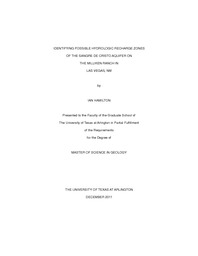
ATTENTION: The works hosted here are being migrated to a new repository that will consolidate resources, improve discoverability, and better show UTA's research impact on the global community. We will update authors as the migration progresses. Please see MavMatrix for more information.
Show simple item record
| dc.contributor.author | Hamilton, Ian | en_US |
| dc.date.accessioned | 2012-04-11T20:57:37Z | |
| dc.date.available | 2012-04-11T20:57:37Z | |
| dc.date.issued | 2012-04-11 | |
| dc.date.submitted | January 2011 | en_US |
| dc.identifier.other | DISS-11467 | en_US |
| dc.identifier.uri | http://hdl.handle.net/10106/9613 | |
| dc.description.abstract | Groundwater at the periphery of mountain ranges in the desert southwest has its provenance in two possible sources: local or regional flow. This study sought to identify the source of deep groundwater from wells on ranches in the Hogback area west of Las Vegas, NM, an area under scrutiny as a possible source for municipal use. Surface and groundwater samples were taken in the area and analyzed for water chemistry and stable isotope ratios of deuterium and oxygen-18. Ratio values were plotted against the Global Meteoric Water Line (GMWL) and also plotted on an interpolated map of precipitation values for the contiguous United States. The area plots on the map in the same precipitation range as Albuquerque, and the sampled waters cluster around the median value for Albuquerque precipitation presented by Yapp, 1986. Sampled values of surface water bodies fed by local precipitation were closely related to the deep groundwater well values, but were generally more negative. These results negate the possibility of recharge from a regional flow regime, and show that groundwater sampled in the Hogback area is sourced from a local flow regime fed by the same precipitation recharging hydrological features around the Gallinas River, including the river itself, upland groundwater and the Montezuma Hot Springs. Chemical data from Piper grouping and ion plots supports this interpretation, and support the possibility that infiltration from surface water bodies is occurring. This conclusion correlates groundwater west of the Precambrian uplift to groundwater to the east of its impermeable breccia zone. This correlation calls into question the extent and permeability of the breccia zone responsible for the Hot Springs. This study represents both the first set of stable isotope data and the first investigation of source data for groundwater in the area of Las Vegas, NM. | en_US |
| dc.description.sponsorship | Hu, Qinhong | en_US |
| dc.language.iso | en | en_US |
| dc.publisher | Geology | en_US |
| dc.title | Identifying Possible Hydrologic Recharge Zones In The Sangre de Cristo Aquifer on The Milliken Ranch in Las Vegas, NM | en_US |
| dc.type | M.S. | en_US |
| dc.contributor.committeeChair | Hu, Qinhong | en_US |
| dc.degree.department | Geology | en_US |
| dc.degree.discipline | Geology | en_US |
| dc.degree.grantor | University of Texas at Arlington | en_US |
| dc.degree.level | masters | en_US |
| dc.degree.name | M.S. | en_US |
Files in this item
- Name:
- Hamilton_uta_2502M_11467.pdf
- Size:
- 3.272Mb
- Format:
- PDF
This item appears in the following Collection(s)
Show simple item record


